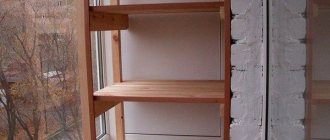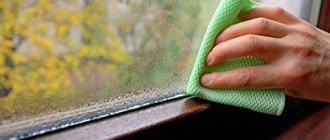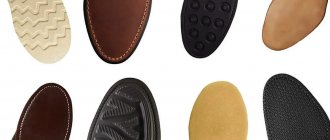What is not stored on our balconies! Old furniture, winter supplies, grandma's library, hunting equipment, a chest with vintage outfits and a fringed floor lamp that still works, so it can't be taken to a landfill. Let's find out whether it is possible to store shoes on the balcony in winter and summer, among other things - boots and shoes, sneakers and shoes, which are worn strictly according to the seasons, most of the time they are forced to simply lie on the shelves.
Balcony – storage room or recreation room?
When discussing the functionality of balconies, everyone relies on personal experience. For one, the balcony is a place to store a bicycle, for the second it is a luxurious warm greenhouse, for the third it is simply a decorative “patch” framed by an openwork wrought-iron fence. It all depends on the purpose of the additional space that extends beyond the boundaries of the heated living space.
Previously, when glazing was out of the question, balconies were also used in different ways. If the facades of buildings faced the central streets of large cities, then it was forbidden to arrange dumps of old furniture or drying racks for washed clothes on the balconies - everything had to look equally decorous and noble.
In the provinces, on the contrary, loggias and balconies were turned into small storage rooms for storing conservation, unnecessary things, or building materials remaining after renovation. Just look at the terraces of the famous Odessa courtyards, crossed by lines with drying laundry, or the balconies of “panels” with old refrigerators playing the role of a closet.
The advent of glazing has changed the attitude towards additional meters - they are being turned into a full-fledged residential area. To do this, apartment owners install thermal insulation, install energy-saving double-glazed windows, and decorate the balcony as a full-fledged interior. In the place where there used to be a gray concrete slab and metal fencing, a cozy lounge, office or workshop appears.
If it is possible to normalize the humidity and air temperature, favorable conditions for storing clothes and shoes will appear on the loggia. You can even arrange a dressing room in such a room.
Why storing shoes on the balcony is not recommended
Balconies and loggias in most typical apartments are not suitable for storing shoes. They do not maintain the required microclimate year-round. As a result, shoes, which even a family of four has a lot of, become unsuitable for wearing.
If in the warm season the loggia or balcony is well illuminated by the sun, then the air there will be dry and heated to high temperatures. This entails:
- lag of soles, straps and adhesive-based decor;
- drying and cracking of leatherette, leather;
- burnout of products.
>
Sole lag on winter boots
High humidity combined with a lack of sunlight is a typical picture of northern or northwestern loggias. If we add to this poor ventilation of the room, then unpleasant consequences occur in the form of destruction of the shoes from the inside.
Moisture enters micropores, causing deterioration in the quality of fur, insulation, and leather. As a result, they lose their performance properties:
- do not retain heat well;
- allow moisture to pass through;
- does not remove sweat well enough, unpleasant foot odors;
- become deformed and become a breeding ground for mold.
Even greater negative consequences can be expected if wet shoes or boots freeze.
Moldy things emit an unpleasant odor
>
Another danger for this wardrobe item on the loggia is dust. Thanks to regular ventilation of the room during the warm season, it actively accumulates in all its corners. Especially a lot of it is collected from those who live in close proximity to a parking lot, road, or large playground.
While cleaning leatherette is not particularly difficult, removing dust from fur, suede and nubuck will be more difficult. Improper cleaning will result in dirty spots and streaks.
Dirty spot after unsuccessful cleaning
You can avoid all the unpleasant consequences associated with storing shoes on the balcony if you create a suitable microclimate in the room.
External surface care
Wash your shoes thoroughly in warm running water. If the dirt is stubborn and dried, then use a toothbrush. A toothbrush works well to remove hard-to-reach dirt where the boot leather meets the sole. If dirt has gotten into the micropores and cracks, try washing it with a special shampoo or foam for shoes. Such products do not contain concentrated caustic substances that corrode and dry the skin. After the shoes are washed and dried, lubricate them with shoe polish. The cream will be absorbed and will prevent the skin from cracking during long-term storage.
Which balcony is suitable for storing shoes?
To store wardrobe items, the balcony is at least glazed and insulated. This will avoid sudden changes in temperature and maintain it constantly at +15..+25°C.
During the cold season, you can take heating appliances out onto the loggia, but you should not place shoe racks next to them.
The room also eliminates the possibility of condensation and increased air humidity. To do this, organize regular ventilation. The optimal humidity level is 50-60%.
The loggia is protected from exposure to ultraviolet rays. To do this, use blinds, curtains or a special darkening film on glass.
Option for shading a loggia using blinds
A clean room means less risk of things being damaged. Regular wet cleaning is enough to prevent dust from settling on suede shoes or fur boots.
For long-term storage of shoes, only a warm, ventilated balcony, protected from dust and precipitation, is suitable.
General rules for storing shoes
To be able to store shoes on the balcony, there must be a comfortable microclimate there, as in residential premises. However, not everything depends on the location; proper preparation of pairs intended for storage is important. Therefore, first, let’s look at what needs to be done to ensure that your shoes or sandals retain their freshness, elasticity, and presentable appearance by May.
You can’t fit all the family’s shoe gear in the hallway.
Main storage rules:
- Humidity contributes to the destruction of the material and the appearance of mold, so dry everything without exception. It is better to dry not on a heating radiator, but in the shade in the fresh air or using a special dryer.
- First thoroughly clean the upper trim and the inside of the shoes - remove fresh stains and stains that cannot be removed after a while.
- If necessary, make minor repairs yourself or take your sneakers, shoes or boots to a workshop. The seasons, as we know, change suddenly, so you need to be prepared for the rapid onset of cold weather or an unexpected thaw.
- The choice and preparation of the site are no less important. It is better if it is a darkened but ventilated space that is easily accessible.
- Dry leather or synthetic materials are no better than dampness, so do not put sandals, sneakers and ankle boots near heating appliances.
- A special cream or spray for the care of natural leather, suede, nubuck, lacquered surfaces, and natural fabric will help preserve the material.
- For each pair, select a separate cell or box - this way the shoes or boots will retain their shape and will not suffer from accidental mechanical damage. Avoid bending and twisting, which also negatively affects the appearance and can also cause rapid wear.
If you follow the recommendations, your favorite boots will easily survive the hot summer, and sandals will remain just as comfortable and attractive by spring.
“Original” or special boxes are recognized as the best storage cells
The prepared shoes are folded in pairs and placed separately. The following storage options are considered successful:
- boxes;
- containers;
- organizers;
- covers.
>
When packaged, pairs are more convenient to move, take out, and label.
Transparent plastic containers do not need to be opened to identify the contents
The boxes are placed in a closet or on shelves. When storage conditions are ideal, pairs are arranged without packaging.
If you plan to store shoes on the balcony in winter or rainy autumn, prepare the room. The space should be glazed and warm, with an air temperature not lower than +18ºС. If insulation is not enough, use efficient heating options in winter, such as underfloor heating. Be sure to adjust ventilation.
Boxes
They are quite convenient and practical. The only drawback is that through them you cannot see what shoes are stored there. The improved model has a viewing window on the side wall.
You can buy such boxes in a specialized online store, or you can make them yourself from cardboard and a piece of transparent polyethylene. The explanatory drawing on the lid will also make it much easier to find the right pair of boots if necessary.
How to compactly store shoes on a loggia and balcony
The choice of storage method for shoes (as well as clothes, books, toys) depends on the volume of the room and the furniture that is installed there. If there is enough free space, experiment with chests of drawers and shelves; if there is a shortage of space, it is better to get by with an ergonomic closet. Let's consider all the options and choose the one that suits you.
Shoe cabinets
Economic owners of balconies have long found a great way to store things that are rarely used or simply put aside for a long time. These are traditional pieces of furniture - cabinets created specifically to accommodate a wardrobe.
Convenient wardrobe with sliding doors
In standard buildings with small loggias and balconies, the only place to install a cabinet is at the end. To save useful space, hinged doors are replaced with sliding ones or the frame is simply separated by a system of blinds. However, many still use standard cabinet models, equipping them with modern fixtures - as in the photo below.
Wooden wardrobe with hinged doors and shoe panels instead of drawers
What is the difference between shoe cabinets on the balcony and ordinary wardrobes? They must be ventilated. Having installed a wardrobe in the bedroom or hallway, you constantly use it, that is, you ventilate it naturally every day.
Balcony storage systems are not designed for frequent opening, so provide ventilation in advance. To do this, holes are drilled in the doors or simply not completely covered. The original option is a “blind” door design.
Chest of drawers with shutter doors
Instead of a blank canvas, a finishing made of thin slats was used, which at the same time close the interior space and allow it to “breathe”.
Convenient shelves for shoes
No matter how practical the cabinets are, the first place in popularity is occupied by open and closed shelves. Their advantage is mobility, ease of manufacture and installation. Enterprising owners do not buy shelves in the store, but build them from scrap materials - the result is stylish and creative.
Stylish shelf made of drawers
Even small shelves installed under a table or hanging from a wall can hold several pairs of shoes.
Shelves located under the table
Look around and look for suitable pieces of furniture in the apartment. Perhaps the old bookcase no longer fits into the interior of the bedroom, but on the balcony it will be just in place - suitable for storing various things, including shoes.
Why not use a rack to store your favorite shoes?
When building or purchasing shoe shelves on your balcony, you can experiment with design to your heart’s content. If you love shabby chic, paint a wooden shelf pink and make it look old; if you prefer minimalism, install a spacious, rectangular shelving that reaches the ceiling; if you admire modernism, decorate the shelf with floral paintings.
>
Forged stands for cowboy boots
On small-sized shelves or racks you can improve your artistic skills and abilities in finishing various surfaces. If the experiment fails, it would be a good idea to send the self-decorated bookcase to the landfill. But there is a chance to encounter an amazing result that you are not ashamed to show to your guests.
Storing shoes opens up opportunities for creativity
In limited space, compactness and functionality are welcome. Why not adapt a bench for storing shoes on the balcony, equipping it with a couple of shelves?
Compact shelves with a hiding place for useful little things
No scattered, randomly hung shelves can compare with full-wall shelving - provided that the space allows. The idea can be implemented in such a way that the entire internal space will turn into a convenient modern storage system with various compartments and sections.
A well-thought-out storage system - there is enough space for a good rest and for storing shoes and boots
Shoe rack is the best solution
The bed was invented to make it comfortable to sleep, the table - to eat and write, and the shoe rack - to properly fold shoes. A properly designed shoe rack meets two important requirements:
- favorable conditions for storing shoes;
- ease of use.
Another requirement concerns the locker configuration. Since this piece of furniture is installed in hallways and corridors, which are cramped, shoe racks have compact sizes and a “narrowed” shape.
Practical use of interior space
Flat-looking cabinets that are installed close to the wall are called slim shoe racks. The depth of wardrobes for bedrooms is up to 60 cm, compact wardrobes for hallways are 40-50 cm, and for shoe racks this parameter is even smaller - 20-30 cm. The secret lies in the design of the shelves, they are folding. When closed, their shoes move to a vertical position, taking up minimal space. At the same time, it fits freely inside the cabinet; adjacent pairs do not touch each other and do not mix.
Neat slim cabinets with folding drawers
The height of slim structures reaches human height; they can accommodate dozens of pairs of shoes. However, when installing a tall model, we recommend that you play it safe by fixing the upper part of the rear wall to the wall. This way the furniture will gain stability and will not fall if the shelves are pulled out sharply. For ease of installation, prudent manufacturers equip tall, narrow shoe racks with loops or hooks for attaching to the wall.
All shoes in one place
The advantages of narrow shoe racks allow you to use them as a shoe cabinet on the balcony. Place the shoe rack against a free wall without the risk of taking over the aisle. To get the pair you are interested in, you just need to pull the handles or brackets - the shelf, having turned 50-90°, will move to a horizontal (or relatively horizontal) position and reveal a neatly laid out assortment.
Alternative methods
What could be more convenient than shelves and cabinets with horizontal shelves? It turns out there are an endless number of options. We present easy-to-implement ideas that you never even thought of before.
Great solution for open walls
If you live by the principle “you can never have too many shoes” - this option is definitely for you! A pair of slats along the walls is a suitable alternative to a bulky cabinet. And the fact that shoes and sandals are visible does not spoil the interior at all.
Convenient place for high heels
Even a metal staircase, which has nothing to do with furniture or decor, can turn into a decorative storage for your favorite shoes. However, the right flight of thought - and the sandals were successfully placed along the wall.
>
Metal ladder for shoes and sandals
And the next trick was known to our grandmothers, who put the dowry in large forged chests. A couple of soft pillows on top - and the chest turned into a comfortable bench.
A magical spacious chest that serves as storage
If you have enough space, you can go for a more challenging experiment: paint ordinary wooden boxes in different colors and fix them on the wall and floor in a free order. A simple idea, but the result is fantastic!
Turning drawers into decorative shelves for boots and boots
Thrifty housewives whose children have already grown up will find a use for toy boxes. Legos, cars, dolls are sent to little relatives, and boots and shoes take their place.
Plastic storage system
The next couple of ideas will be useful to those who want to make an original mini-shoe rack with their own hands, quickly and inexpensively. A cylindrical wooden block + several narrow crossbars - and the “hedgehog” for shoes is ready.
Simple, easy, original
Do you like shocking colors and stunning combinations of colors? You will like the next option. Bars, boards, screws + acrylic paint - that's all you need.
An ordinary pallet made of boards, painted in bright colors
There are a lot of ideas. The main thing is not to limit yourself to standard models, to follow your own fantasies.
Video tips and ideas for organizing shoes
Using organizers instead of regular shoe boxes:
Tips for preparing for storage:
How to make a shoe cabinet with your own hands:
Shoe rack made from plywood sheet:
There are many options for storing shoes on a balcony or loggia - in cabinets, on shelves and open. However, all of them are possible only under one condition: the room is warm, dry and protected from direct sunlight.
YOU MAY ALSO BE INTERESTED
Possible options
Despite all the contraindications, it is possible to store winter and mid-season shoes on the balcony. But this will require constant monitoring. At intervals of one and a half to two weeks you will have to take it out and ventilate it. But this is only the case when the air on the loggia does not heat up to high temperatures.
If serious problems arise with storing winter shoes, then with summer shoes everything is much simpler. The fact is that with the onset of cold weather, the loggia begins to be heated, and accordingly the microclimatic conditions of the room become relatively stable. Therefore, you can store stocks of slates, slippers, sneakers and shoes without fear for their condition. For tips on storing winter shoes, watch this video:
This information confirms that you can store shoes on the balcony only when it is well heated. But even in this case, it must be periodically ventilated, and in some cases dried. Other options are strictly not allowed, otherwise with the beginning of the next season you will have to buy a new pair, and maybe more than one.
Source











